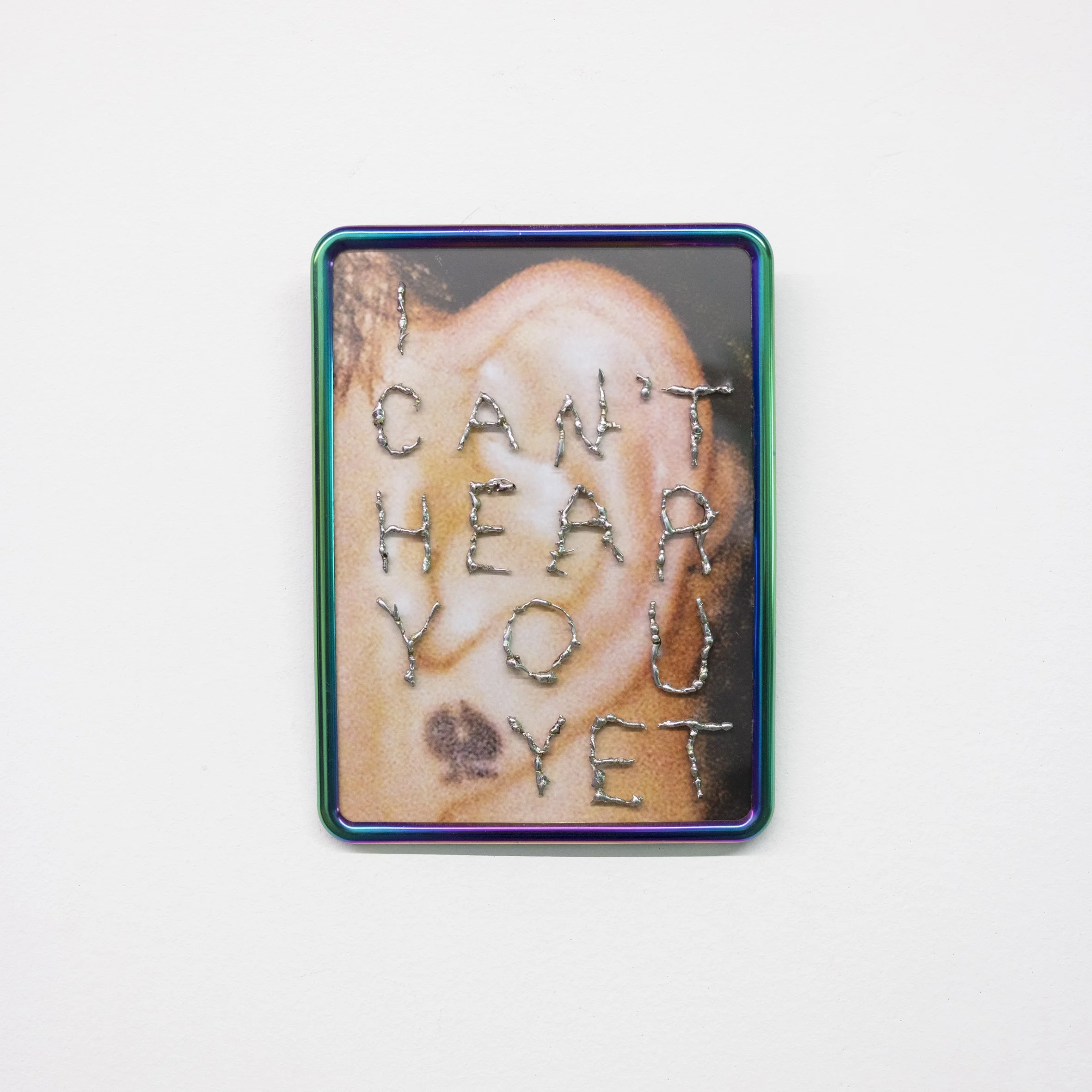OTHERWORLD COMMUNICATION
A Prune Phi Solo Exhibition
Prune Phi - Altar [Cans], 2022. Acier brut, photographie, sticker
60 x 90 x 8,5 cm
CURATORIAL STATEMENT
Prune Phi - I can’t hear you yet, 2022. Plaque d’immatriculation de scooter, photographie, étain.
14,8 x 18,8 cm
Welcome to Otherworld Communication. Our telecommunication company offers the best spiritual correspondence services on the market, with an exceptional coverage reaching heaven, limbo, hell, and any other spaces in between. Our business ensures that the information you give us reaches the afterlife safely, and that your loved ones receive their due on time. Make an appointment now with our operator Prune Phi, who will welcome you to our office and provide a personalised consultation tailored to your needs and requirements.
Otherworld Communication is a fictitious telecommunication company specialised in contacting the deceased. Created by French-Vietnamese artist Prune Phi, it is operated through installations and performances, activated by the artist in the form of private consultations. The public is invited to make an appointment for a personalised meeting with Phi, fully absorbed in her role as a telecommunication operator. She encourages the participant to write a personal message to a deceased loved one, which is then printed on a smartphone made of paper, creating a text message that can be sent to the desired person by burning the object.
Part of the French-Vietnamese diaspora, Phi’s inspiration for this project comes from the tradition of burning joss paper for the dead, a custom passed down to her from her grandfather. The paper symbolises bank notes and their burning allows them to be sent to the departed. As they are unable to take anything with them, the deceased find themselves destitute upon their arrival in the afterlife. Their descendants are thus required to diligently burn the necessary money to ensure the well-being of their ancestors.
This practice has evolved with time. What started with simple bank notes now includes minute replicas of various objects ranging from paper shoes to watches, houses and even…smartphones. We are witnessing the introduction of new technologies in our traditions, leading the artist to explore the role this encounter can play in shaping our cultural knowledge. What possibilities arise from the convergence of two seemingly opposed domains? Phi offers a contemporary reading of this ritual, bringing together technology, culture, transmission and memory. We are suspended between the spiritual and the virtual, meeting the artist at the heart of her practice in an environment as enchanting as it is perplexing.
At first, Prune’s peculiar world entices us by its playful nature but the sincerity of her listening catches us off guard. The façade dissolves as uncertainty gives way to bewitchment and the distance between performance and reality collapses, a true sense of worship permeating the space. It isn’t the world of the dead or of the living that the artist is interested in, as much as the bridge that connects them, with their contradictions and similarities. Phi favours multiplicity by straddling these inter-worlds. A twofold vision echoing the diasporic condition, an identity imbued with pluralities where loss and translation meet discovery and wonder.
Otherworld Communication is as much a lighthouse as it is a mirage, another dimension where a distinct cultural-technological experience can be propagated. The artist inhabits this ritual, she becomes it, she is both vessel and occupant of her own creation.
The Vietnamese-American poet Ocean Vuong describes language as our most powerful technology, a tool with the power to shape our reality. Otherworld Communication presents several aspects we can link to this reasoning, namely: text, translation and cultural storytelling. What form does language take in this situation? Is it the message written by the participant or could it be Prune’s cultural translation ? Perhaps the very act of burning the object could be a gesture that embodies a language without words. Could we consider worshiping as an ancestral technology, or equate cultural heritage to a tool? The artist's performance plays and restructures our understanding of these notions.
Immersed in this futuristic setting, we are also seduced by the artist's metallic sculptures, shown for the first time in this context. These collages made of personal archives are at once gentle and impenetrable, resembling residual memories from hallucinatory dreams and bringing to mind pixelated images- akin to a visual glitch. Here, Phi is inspired by the customisation of scooters in Vietnam, a practice associated with Vietnamese youth which the artist imbues with pictures of fleeting encounters, a peculiar combination hinting at movement and emancipation. Their scattering throughout the exhibition space echoes the fragmentation of one’s identity, and as they unfold we are met with a deeper comprehension of the artist's practice: she sprinkles her works with the people she has met, the stories she has heard and the memories that survive through time. Phi is a translator-interpreter, a guide and a wanderer in her phantasmagorical world. She forces us to confront our own past and turns intimacy into a space of sharing and rediscovery.

